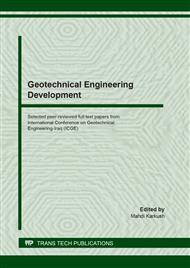[1]
K. Miled., Effet de taille dans le béton léger de polystyrène expansé, Mémoire de thèse de Doctorat, Ecole Nationale des Ponts et Chaussées, Mécanique, Structures et Matériaux, p.181 (2005).
DOI: 10.1007/bf02478815
Google Scholar
[2]
A. Muhammad Riaz Chen, Bing., Experimental research on the performance of lightweight concrete containing foam and expanded clay aggregate, Composites Part B: Engineering., 171 (2019), 46-60.
DOI: 10.1016/j.compositesb.2019.04.025
Google Scholar
[3]
A.M. Rashad, Lightweight expanded clay aggregate as a building material–An overview, Construction and Building Materials. 170 (2018) 757–775.
DOI: 10.1016/j.conbuildmat.2018.03.009
Google Scholar
[4]
F. Colangelo, F. Ilenia, Lightweight concrete with polyolefins as aggregates, Use of Recycled Plastics in Eco-efficient Concrete. (2019) 167-187.
DOI: 10.1016/b978-0-08-102676-2.00008-6
Google Scholar
[5]
J. Mohammed, Ali. Hamad, Materials, properties and application review of lightweight concrete, Rev. Téc. Ing. Univ. Zulia. 37(2) (2014) 10-15.
Google Scholar
[6]
C.C. Yang, R. Huang, Approximation Strength of Lightweight Aggregate Using Micromechanics Method, Adv. Cem. Based Mater. 7(3–4) (1998) 113–138.
Google Scholar
[7]
Y. Ke, S. Ortola, A.L. Beaucour, H. Dumontet, Identification of Microstructural Characteristics in Lightweight Aggregate Concretes by Micromechanical Modelling Including the Interfacial Transition Zone (ITZ), Cem. Conc. Res. 40(11) (2010) 1590–1600.
DOI: 10.1016/j.cemconres.2010.07.001
Google Scholar
[8]
S. Kurugöl, L. Tanaçan, H.S. Ersoy, Young's Modulus of Fiber-Reinforced and Polymer-Modified Lightweight Concrete Composites, Constr. Build. Mater. 22(6) (2008) 1019–1028.
DOI: 10.1016/j.conbuildmat.2007.03.017
Google Scholar
[9]
L. Tanaçan, H.Y. Ersoy, Mechanical Properties of Fired Clay-Perlite as Composite Material, J. Mater. Civil Eng. ASCE. 12(1) (2000) 55–59.
DOI: 10.1061/(asce)0899-1561(2000)12:1(55)
Google Scholar
[10]
HZ. Cui, Study of prediction model for compressive strength of lightweight aggregate concrete, Adv Mater Res. (2011) 1204–1209.
DOI: 10.4028/www.scientific.net/amr.335-336.1204
Google Scholar
[11]
Y. Ke, A.L. Beaucour, S. Ortola, H. Dumontet, R. Cabrillac, Influence of volume fraction and characteristics of lightweight aggregates on the mechanical properties of concrete, Constr. Build. Mater. 23(8) (2009) 2821–2828.
DOI: 10.1016/j.conbuildmat.2009.02.038
Google Scholar
[12]
T.Y. Lo, H.Z. Cui, Effect of porous lightweight aggregate on strength of concrete, Mater. Lett. 58 (2004) 916-919.
DOI: 10.1016/j.matlet.2003.07.036
Google Scholar
[13]
A. Ardakani, M. Yazdani, The relation between particle density and static elastic moduli of lightweight expanded clay aggregates, Appl. Clay Sci. 93–94(2014) 28–34.
DOI: 10.1016/j.clay.2014.02.017
Google Scholar
[14]
P. Gilormini, Y. Bréchet, Syntheses: Mechanical Properties of Heterogeneous Media: Which Material For Which Model? Which Model For Which Material?, Mod. Simul. Mater. Sci. Eng. 7(5) (1999) 805–816.
DOI: 10.1088/0965-0393/7/5/312
Google Scholar
[15]
T.C. Hansen, Strength Elasticity and creep as related to the internal structure of concrete. In: Chemistry of cement, Proceedings of fourth international symposium, Monograph.Vol. 2, 709, 709–723, Washington, (1960).
Google Scholar
[16]
S. Popovics, M. Erdey, Estimation of the Modulus of Elasticity of Concrete-Like Composite Materials, M.R.A. Mater. Struct. 3(4) (1970) 253–260.
DOI: 10.1007/bf02474013
Google Scholar
[17]
Y. Ohama, Principle of Latex Modification and Some Typical Properties of Latex-Modified Mortar and Concrete, ACI Mater. J. 84(6) (1987) 511–518.
DOI: 10.14359/2463
Google Scholar
[18]
T.J. Hirsch, Modulus of elasticity of concrete affected by elastic moduli of cement paste matrix and aggregate, ACI J. 59(3) (1962) 427–452.
DOI: 10.14359/7924
Google Scholar
[19]
L.E. Nielsen, P.E. Chen, Young's Modulus of Composites Filled With Randomly Oriented Short Fibers, J. Mat. 3(2) (1968) 352–358.
Google Scholar
[20]
T.C. Hansen, Influence of aggregate and voids on modulus of elasticity of concrete, cement mortar, and cement paste, ACI J. 62(2) (1965) 193–216.
DOI: 10.14359/7686
Google Scholar
[21]
F.P. Zhou, F.D. Lydon, B.I.G. Barr, Effect of Coarse Aggregate on Elastic Modulus and Compressive Strength of High Performance Concrete, Cem. Conc. Res. 25(1) (1995) 177–186.
DOI: 10.1016/0008-8846(94)00125-i
Google Scholar
[22]
U.J. Counto, The Effect of the Elastic Modulus of the Aggregate on the Elastic Modulus, Creep and Creep Recovery of Concrete, Mag. Conc. Res. 16(48) (1964) 129–138.
DOI: 10.1680/macr.1964.16.48.129
Google Scholar
[23]
H.H. Bache, P. Nepper-Christansen, Observations on strength and fracture in lightweight and ordinary concrete-the Structure of concrete and its behavior under load, Proceedings of International Conference, Cement and Concrete Association. 93–108, London, (1965).
Google Scholar
[24]
K. Miled, R. Le Roy, K. Sab and C. Boulay, Compressive behavior of an idealized EPS lightweight concrete: size effects and failure mode, Mechanics of materials. 36(11) (2004) 1031-1046.
DOI: 10.1016/j.mechmat.2003.08.004
Google Scholar


